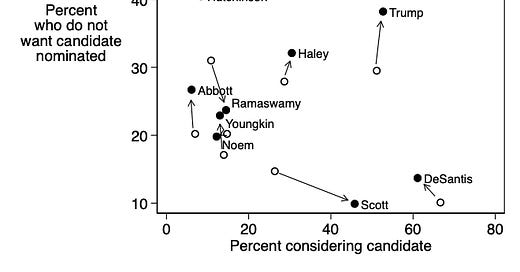Just a bit more data from my latest survey of Republican county chairs! Mainly because I don’t want to let a fun graph go to waste.
In the graph below, I plot out the changes in support for Republican presidential candidates between the April and June surveys. Each candidate is plotted by the chairs’ responses to two questions: Which candidates are you considering supporting, and which do you definitely not want to see become the Republican nominee? The percent of chairs considering a candidate runs along the horizontal axis and the percent opposed to the candidate is on the vertical axis. Each candidate appears twice, with hollow dots representing their numbers in the April survey and solid dots the June survey.
This allows us to see how much candidates have moved in the party chairs’ estimation. The arrows show just how much movement has occurred. Generally speaking, the best candidates can do is to move downward and rightward – lowering the number of chairs who oppose them while improving the number who are considering them.
By this standard, Tim Scott wins the Most Improved award, following a strong and conventional campaign rollout, heavy advertising, and many visits to early contest states. Vivek Ramaswamy, while still not on many people’s radar, also had some decent movement down and to the right. And it wasn’t a terrible time period for Mike Pence, although arguably a former Vice President should be in a stronger situation to begin with.
Ron DeSantis is still in a strong position — the bottom right of the graph is generally a good place to be — but he’s moving in a harmful direction for him, if only slightly. Trump mainly saw his negatives grow between those two months.
I wouldn’t read too much into this, given the variations in samples from survey wave to survey wave. But it’s useful to consider not just position but direction, and we get some sense of that here.






The racist party is not going to nominate a black guy, let's be serious now.
Tim Scott would have a great chance to win on the 4th ballot if conventions still worked like it waa 1948.